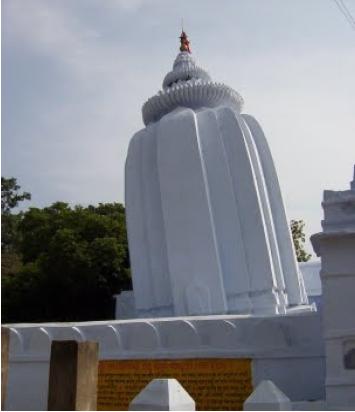- ETYMOLOGY:-The name Konark is derived from the Sanskrit word Kona (meaning angle) and word Arka (meaning sun) in reference to the temple which was dedicated to the Sun god Surya.
- ARCHITECTURE:- Located on the shoreline, now a little over 3 km from the sea, the temple takes the form of the chariot of Surya (Arka), the Sun God, and is heavily decorated with stone carving. The entire complex was designed in the form of the God's huge chariot drawn by seven spirited horses on twelve pairs of exquisitely decorated wheels at its base. The huge wheels carved at the base of the temple are one of the major attractions. The spokes of the wheels serve as sundials and the shadows cast by these can give the precise time of the day. The pyramidal roof soars over 30 m (98 ft) in height. The temple complex also contains erotic sculptures similar to the temple in Khajuraho.The entrance is guarded by two giant lions, which are each shown crushing a war elephant. Each elephant in turn lies on top of a human body.Here lion is represented as pride and elephant is represented as money both money and pride crushes man. The temple symbolizes the majestic stride of the Sun God. At the entrance of the temple is a Nata mandir. This is where the temple dancers used to perform dances in homage to the Sun God. All around the temple, there are various floral and geometric patterns. The temple is now partly in ruins, and a collection of its sculptures is housed in the Sun Temple Museum, which is run by the Archaeological Survey of India. The poet Rabindranath Tagore wrote of Konark: "Here the language of stone surpasses the language of man."The Sun Temple, built in the thirteenth century, was conceived as a gigantic chariot of the Sun God, with twelve pairs of exquisitely ornamented wheels pulled by seven horses. Majestic in conception, this temple is one of the most sublime monuments of India, famous as much for its imposing dimensions and faultless proportions as for the harmonious integration of architectural grandeur with plastic allegiance. Every inch of the temple is covered with sculpture of an unsurpassed beauty and grace, in tableaux and freestanding pieces ranging from the monumental to the miniature. The subject matter is fascinating. Thousands of images include deities, celestial and human musicians, dancers, lovers, and myriad scenes of courtly life, ranging from hunts and military battles to the pleasures of courtly relaxation. These are interspersed with birds, animals (close to two thousand charming and lively elephants march around the base of the main temple alone), mythological creatures, and a wealth of intricate botanical and geometrical decorative designs. The famous jewel-like quality of Orissan art is evident throughout, as is a very human perspective which makes the sculpture extremely accessible.The temple is famous for its erotic sculptures, which can be found primarily on the second level of the porch structure. It will become immediately apparent upon viewing them that the frank nature of their content is combined with an overwhelming tenderness and lyrical movement. This same kindly and indulgent view of life extends to almost all the other sculptures at Konark, where the thousands of human, animal, and divine personages are shown engaged in the full range of the 'carnival of life' with an overwhelming sense of appealing realism. It is admittedly the best in Orissa. Its fine traceries and scrollwork, as well as the beautiful and natural cut of animal and human figures, give it a superiority over other temples.The Sun temple belongs to the Kalinga school of Indian temple architecture. The Main Sanctum which (229 ft. high) was constructed along with the Audience Hall (128 ft. high) having elaborate external projections. The Main Sanctum which enshrined the presiding deity has fallen off. The Audience Hall survives in its entirety, but only small portions of the Dancing Hall (Nata Mandir) and the Dining Hall (Bhoga-Mandap) have survived the vagaries of time. The Temple compound measures 857 ft (261 m) by 540 ft (160 m). The alignment of the Sun Temple is on the East-West direction. The Temple is located in natural surroundings, abounding with casuarina plantations and other types of trees such as mahogany, rosewood, eel which grow on sandy soil.
- HISTORY:- The large structure seen today is actually the mantapa (mandap). Of the main tower, which once stood in the front, only the remains can be seen. This tower (deul) was perhaps 200 feet (60 metres) tall, higher than any other temple in India.
- KALAPAHAD:- The most popular theory about the root of the fall of Konark temple rests with the Kalapahad, the general of Bengal Sultan Sulaiman Khan Karrani. According to some accounts Kalapahad was formerly a Hindu Kayastha officer, however he had converted to Islam. According to Afsanah-i-Shahan of Shaikh Kabir Batini, he was a Batini Afghan. According to the history of Orissa, Kalapahad invaded Orissa in 1568. He destroyed Konark temple, as well as a number of Hindu temples in Orissa. The Madala Panji of Puri Jagannath temple describes how Kalapahad attacked Orissa in 1568. Including Konark temple, he broke most of the images in most of the Hindu temples in Orissa. Though the stone walls are of 20 feet (6.1 m) to 25 feet (7.6 m) thick, he somehow managed to displace the Dadhinauti (Arch stone) and thus caused the tower to collapse. He also damaged most of the images and other side temples of Konark. Due to displacement of the Dadhinauti, the tower gradually collapsed and the roof of the Mukasala was also damaged, due to the stones falling down from the temple top.Orissa came under Muslim control in 1568. There were constant attempts to destroy the Hindu temples. The Pandas (priests) of Puri, to save the sanctity of the Puri temple, took away the Lord Jagannath from the Srimandir and kept the image in a secret place. Similarly, it is said that the Pandas of Konark took away the presiding deity of the Sun temple and buried it under the sand for years. Latter on the image was said to have been removed to Puri and kept in the temple of Indra, in the compound of the Puri Jagannath temple. According to others, the Puja image of the Konark temple is yet to be discovered. But others hold the view that the Sun image now kept in the National Museum of Delhi was the presiding deity of the Konark Sun te.In 1626, the then king of Khurda, Raja Narasimha Dev, son of Purusottam Dev, took away the Sun image to Puri along with two other moving deities - Sun and Moon. Now they are found in a temple in the compound of Puri Jagannath temple.As described earlier there was a big block of stone called Navagraha Paata placed in front of the Mukhasa?a. The then king of Khurda removed the block. The king had taken away many sculptured stones from Konark and constructed some portions of Puri temple with them. During Maratha's time the outer compound wall of the Puri temple was constructed of stones from Konark temple.It is reported that among all the temples the Na?a mandira or the Dancing hall, of Konark was in its original form for the longest period, and that it was broken intentionally since it was considered an unnecessary structure during the Maratha administration.In the year 1779, a Maratha Sadhu had taken away the Aruna Khamba (Pillar) from Konark and put it in front of the Lion's Gate of Puri Jagannath temple. Thus by the end of 18th century, Konark lost all its glories and had been turned to a dense forest. In course of time, the temple area thus became devoid of people, covered with dense forest, filled with sand, overrun by wild animals and became the abode of pirates. It is said that even the locals feared to go to Konark in broad daylight.
- MAGNETS & FLOATING IDOLS:- The following are popular sayings from the local populace and the guides.
- Legend has it that, the uniqueness of the temple lies in the fact that between every two stone pieces there lies an iron plate (this can be clearly seen).[10] The temples higher floors have been reinforced using massive iron beams. This fantastic effort in human perseverance took 1200 workers about 12 years to complete and that the ''Dadhinauti'' (Peak) of the main temple had to be installed by the 12 year old son Dharmapada Moharana of the Chief Architect Bishu Moharana. The said peak being a 52 ton magnet. This magnet was the reason the entire edifice endured the harsh conditions (being on the sea front) for centuries without being affected. The main pratima (idol) was believed to be floating in the air because of the unique arrangements of the main magnets and other series of magnets. The placement of the temple had been aligned in a way that the first rays of the Sun falling on the coast would pass through the Nata Mandir and would reflect from the diamond placed at the center of this idol in the Main Sanctum. This phenomena would last for a couple of minutes during the early morning. These magnets were later removed by the Britishers for acquiring the magnetic stone,Other legends state that, the magnetic effects of the lodestone was so strong that it disturbed the ships compasses that passed by the coast and the ships would run aground. To save their trade and their ships, the Portuguese took away the lodestone. The lodestone that was acting as the central stone and keeping all the stones of the temple well balanced, fell out of alignment because of its removal and eventually led to the destruction of Main Sanctum.
- FALL of KONARK:-
- Incomplete TEMPLE:-It is opined by some historians that, due to the early death of the king Langula Narasimha Dev, builder of the Konarak temple, the construction of the temple had been left in a haphazard state. As a result of this, the incomplete structure eventually collapsed. But this view is unsupported by historical data. The records of Madala Panji of Puri Jagannath temple, as well as from some copper plates dated 1278 A.D., state that the king Langula Narasimha Dev reigned till 1282. Many historians are of the opinion that the construction of the Konark temple was completed between 1253 and 1260 A.D. So the argument that the temple collapsed due to non-completion during construction is not tenable.It is also of the opinion of the local populace in Orissa that the temple took almost twelve years to complete and one thousand two hundred persons were engaged in construction of this temple. The leader of this team was a person named Visu Maharana. The temple was only completed after the twelve-year-old son of Visu Maharana laid the final stone on the Sikhara, a feat which had puzzled the team. The state history of Orissa and all school literature makes mention of this however, this has not been researched so far.
- LOADSTONE:- Legends describe a lodestone on the top of the Sun temple. Due to its magnetic effects, vessels passing through the Konark sea were drawn to it, resulting in heavy damage. Other legends state that magnetic effects of the lodestone disturbed ships' compasses so that they did not function correctly. To save their shipping, the Portuguese voyagers took away the lodestone, which was acting as the central stone and keeping all the stones, and the iron columns used to hold them walls together, of the temple wall in balance. Due to its displacement, the temple walls lost their balance and eventually fell down. But there is no record of this occurrence in any historical records, nor is there any record of the existence of such a powerful lodestone at Konark. According to Legend the image of the deity or the statue of the Sun God was built of a material with iron content with 1 large magnet on top of the temple, 1 in the basement and 4 large magnets in the interiors to make the statue hang / float /suspend in air. The question remains though is how the magnets retained their effect over time as all magnetic materials loose their magnetic strength over time.
- KALAPAHAD:- The most popular theory about the root of the fall of Konark temple rests with the Kalapahad. According to the history of Orissa,Kalapahad invaded Orissa in 1508. He destroyed Konark temple, as well as a number of Hindu temples in Orissa. The Madala Panji of Puri Jagannath temple describes how Kalapahad attacked Orissa in 1568. Including Konark temple, he broke most of the images in most of the Hindu temples in Orissa. Though it was impossible to break the Sun temple of Konark, the stone walls of which are of 20 feet (6.1 m) to 25 feet (7.6 m) thick, he somehow managed to displace the Dadhinauti (Arch stone) and thus made a way for the temple to collapse. He also broke most of the images and other side temples of Konark. Due to displacement of the Dadhinauti, the temple gradually collapsed and the roof of the Mukasala was also damaged, due to the stones falling down from the temple top.Consequently, Orissa came under Muslim control in 1568. There were attempts to destroy the Hindu temples. The Pandas of Puri, to save the sanctity of the Puri temple, took away the Jagannath from the temple and kept the image in a secret place. Similarly, it is said that the Pandas of Konark took away the presiding deity of the Sun temple and buried it under the sand for years. Latter on the image was said to have been removed to Puri and kept in the temple of Indra, in the compound of the Puri Jagannath temple. According to others, the Puja image of the Konark temple is yet to be discovered. But others hold the view that the Sun image now kept in the National Museum of Delhi was the presiding deity of the Konark Sun temple.However, the Sun worship in the Konark temple was ended upon the removal of the image from the temple. This resulted in the end of pilgrimages to Konark. The port at Konark was also closed, due to pirate attacks. Konark was as glorious a city for Sun worship as it was for commercial activities, but after the cessation of these activities, Konark became deserted and was left to be enveloped by a dense forest over the years.In 1626, the then king of Khurda (now a district in Orissa), Raja Narasimha Dev, son of Purusottam Dev, took away the Sun image to Puri along with two other moving deities - Sun and Moon. Now they are found in a temple in the compound of Puri Jagannath temple.It is recorded in the Madala Panji of Puri temple that in 1028, Raja Narasimha Dev ordered measurements to be taken of all the temples at Konark. At the time of measurement, the Sun temple was in existence up to its Amalak sila, i.e. about 200 feet (61 m) in height. Kalapahad had only destroyed its Kalas, the crowning stone and the Padma-Dhwaja, the lotus finial and the upper portions.As described earlier there was a big block of stone called Navagraha Paata placed in front of the Mukhasala. The then king of Khurda removed the block. The king had taken away many sculptured stones from Konark and constructed some portions of Puri temple with them. During Maratha's time the outer compound wall of the Puri temple was constructed of stones from Konark temple.It is reported that among all the temples the Naata Mandir or the Dancing hall of Konark was in its original form for the longest period, and that it was broken intentionally since it was considered an unnecessary structure during the Maratha administration.In the year 1779, a Maratha Sadhu had taken away the Aruna Khumba (Pillar) from Konark and put it in front of the Lion's Gate of Puri Jagannath temple. Thus by the end of 18th century, Konark lost all its glories and had been turned to a dense forest. In course of time, the temple area thus became devoid of people, covered with dense forest, filled with sand, overrun by wild animals and became the abode of pirates. It is said that even the locals feared to go to Konark in broad daylight. All these theories with the detailed explanations are given in Pt. Sada Shiv Rathsharma's book titled Sun Temple of Konark, which initiated further research works on the Konark Temple thereby fetching him the Padmashree award and perhaps the first for an Oriya. All further writings have been a subset of this book and no other theory has been proposed.
- LEGENDS:- King Narasimha Deva-I of the Ganga Dynasty had ordered this temple to be built as a royal proclamation of the political supremacy of his dynasty. A workforce of 12 hundred artisans and architects invested their creative talent, energy and artistic commitment for an exhausting period of 12 years. The king had already spent an amount equivalent to the state's revenue receipts of 12 years. However, the completion of the construction was nowhere near sight. Then the king issued a final command that the work be completed by a stipulated date. The team of architects headed by Bisu Maharana was at its wit's end. It was then that Dharmapada the 12 year old son of the chief architect Bisu Maharana arrived there as a visiting on looker. He became aware of the anxiety looming large among the architects. Although he did not have any practical experience of temple construction, he was thorough in his study of the theories of temple architecture. He offered to solve the confounding problem of fixing the last copping stone at the top of the temple. He surprised everyone by doing that himself. But soon after this achievement the dead body of this adolescent prodigy was found on the sea beach at the foot of the temple. Legend says that Dharmapada laid down his life to save his community.The victorious King of Orissa, Narasimhadeva erected a victory pillar designed as a war chariot. This temple was dedicated to Surya the Sun god, at a location near the temple town of Puri. He named this place Konark which means "Essence of the Corners" While the structure commemorates the victory in the battle against the Muslims, the name Konark commemorates the science of astronomy of which the King was an avid student. Another legend related to Sun Temple of Konark: After the easy victories over North India from Punjab, through Bengal, the Muslims turned to attack Orissa. Here the Muslims met their match. The people of Orissa were hardy fighters. (In ancient and medieval times, Orissa was also called Kalinga or Utkal ' from Uttam Kala which means 'Excellent Art' that reflects the artistic tradition of sculpture of that region). The bravehearts of Orissa had given a hard time to Samrat Ashoka Maurya, when in the 3rdcentury BCE. Kumara, the king of Kalinga, gave a tough battle to the Mauryan invader, before Orissa could be annexed to the Maurya Empire.Now in the 13th century, when Tugan Khan one of the afghan general attacked Orissa,[12][13][14] the then ruling king of Orissa, Narsimhadeva, decided to use subterfuge against the Muslims. He sent word to the invaders that he wanted to surrender without a fight, as had Lakshmansena, the ruler of neighboring Bengal. Tugan boasted that he had put the fear of death in the heart of the Hindus and could overrun the entire country in a single campaign. But Narasimhadeva had other ideas. He decided to use the Muslims' patent tool subterfuge against the enemy. He sent word to Tugan that Orissa was ready to surrender to the Muslims without a fight, as had its neighbor Bengal. Tugan accepted Narasimhadeva's surrender proposal and asked for the surrender of the major city of Puri that was an important Hindu Pilgrim center (Narasimhadeva had his capital elsewhere at Jajanagara). Tugan's other conditions included handing over all weapons to the Muslim army, the embracing of Islam by the entire population in the central square in front of the Jagannath Temple or agreeing to pay Jazia and to convert the Jagnnath temple at Puri into a Mosque as an acknowledgement of submission. To the delight of the Muslims, all these terms were accepted and the Muslims advanced into the city, blissfully unaware that the shrewd Hindu king had laid a trap for them. On the orders of Narasimhadeva, the bustling city had been completely evacuated of its pilgrims, the aged and children; and professional soldiers from all over the kingdom had occupied every nook and cranny of the city, hidden away inside the closely built houses across the narrow winding lanes.Once the Muslim army was inside the city, it had to disperse itself into the maze of narrow lanes and bylanes with which they were not familiar and where they had to dismount from their horses and advance single file. Unaware of the danger lurking they advanced cautiously and slowly towards the central square where the surrender ceremony was to take place. When the Muslim army was so dispersed, at a prearranged signal from one of lookouts from the temple spires, the temple bells started ringing, and this was the signal for the Hindus to pounce on the Muslims. The pitched battle lasted one whole day and went into the night pierced by the cries of wounded and dying Muslim and Hindu soldiers. While the Hindus took many losses, the entire Muslim army was caught like as in a mousetrap, and annihilated. Very few Muslims could escape this trap. This bold and unorthodox idea succeeded, and it caught the Muslims totally off-guard as it had never been used till then, by any Hindu king, as it went against the Hindu rules of warfare based on fair-play and fighting a noble war. But, precisely because of it being totally unexpected, the Muslims had to suffer a bloody nose and the Hindus emerged victorious. Consequently Orissa was to remain a Hindu bastion for many centuries and this accounts for the very low percentage of Muslims in Orrisa even today.
- PHOTOS GALLERIES:-
- konark Sub Temple:-
- Nata Mandir:-

- Konark Sun Temple chariot Wheel:-
- Konark Sun Temple at night:-

- Front view of konark temple:-
- A sculpture of Surya - the Sun God at Konark:-

- A notice at Konark Sun Temple premises declaring it as a World Heritage monument:-














































